How to remove nail polish? Easy removal of glitter polish. We remove varnish without friction! Removing Nail Polish: New Secrets
Nail polish is a good thing when you don't have to take it off later. It used to take me up to 30 minutes to remove nail polish using millions of cotton swabs. It was a real waste of time and expensive cotton wool, which I would have needed to clean my ears. Too much information?
One bright sunny day, I was scrolling through my favorite nail blog and came across a clip uploaded to Youtube in which Deborah Lippmann showed a quick and easy way removing nail polish. She's brilliant! I tried her method right away and it worked great. I have been using this method for several months now and I can say that it is the best! I told my friends about this method, and they (those who tried it) immediately appreciated it. Now I will teach this method to you, if you do not already use it.
Step one. Take your supplies. Obviously you will need nail polish remover. I like the one I use. It is acetone free. This is a purely psychological aspect, because as long as you do not use acetone, it does not harm you. In fact, nail polish hurts you more than nail polish remover. Now take cotton balls. It's the balls, not tampons or anything else. They can be purchased at the store. They are very cheap and will last you a long time. For example, I only need 1 to remove nail polish from the fingers of both hands.
Now take the ball. He is so soft and fluffy. Unfold it into one strip.
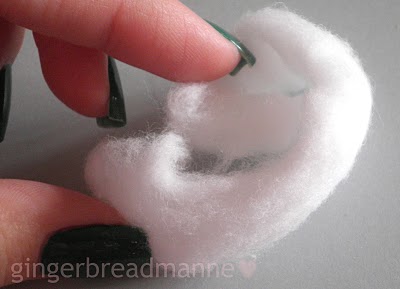
This should be easy, since the ball is formed by twisting it, like a snail shell. 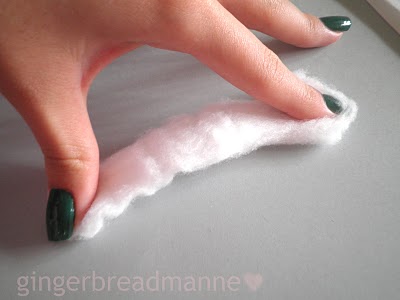
Divide the resulting strip into two parts. I help you save money!
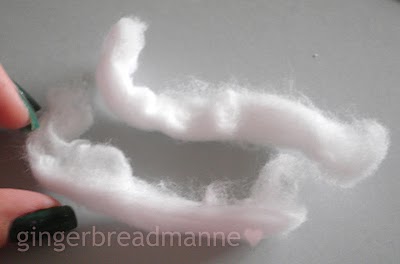
You can continue to separate the strips, but I like to keep them thick enough. Now tear them into small pieces the size of a fingernail. Special precision is not needed here; they will go in the trash anyway.
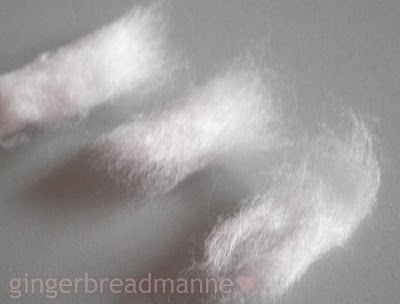
Continue tearing them off until you have 12-15 of these pieces. Usually 10 is enough for nails, and the rest are needed to remove the remaining polish. 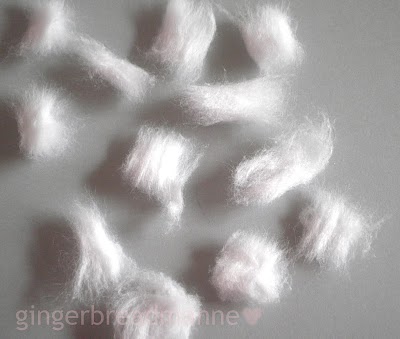
So, your pieces of cotton wool are ready. Now pour your nail polish remover into the cap. 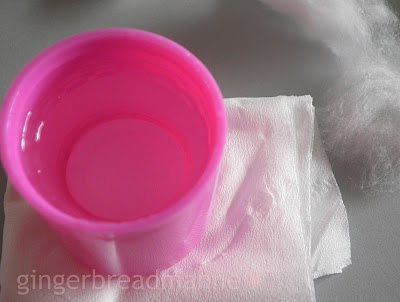
Now take one of these cotton balls and soak it in nail polish remover. However, do not get carried away too much so that the product does not run down your fingers when you press the cotton wool against your nail. The stream can reach your elbow. This has happened to me. Not a very pleasant experience, let me tell you.
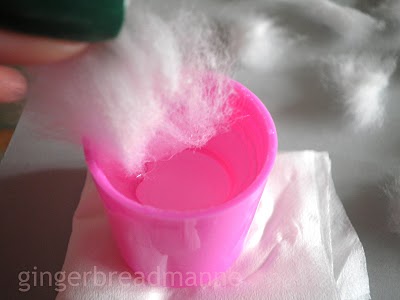
Now gently press the cotton wool onto your nail. The cotton wool should be well soaked in the product and completely cover your nail. 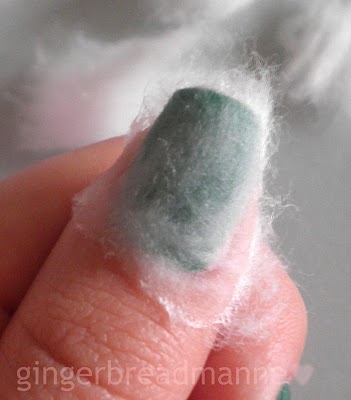
Now do the same with the rest of your nails.

Do not remove the cotton wool from your nails for 1-2 minutes. This time is necessary for the nail polish remover to complete its task. This works almost the same as if you dipped your nails in the liquid, but is not as damaging to your skin. Plus, your nails won't absorb nail polish remover. As I said earlier, the product will cause much less harm than varnish. Now you should take a new piece of cotton wool and, pressing it firmly against the wet cotton wool, remove the latter from the nail. Do this from the base of the nail to its end. Thanks to this method, your nails will not be damaged.
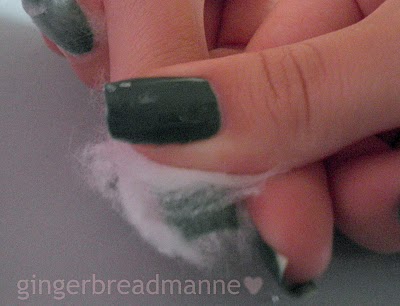
If you did everything correctly, most (if not all) of the polish should have come off your nails.
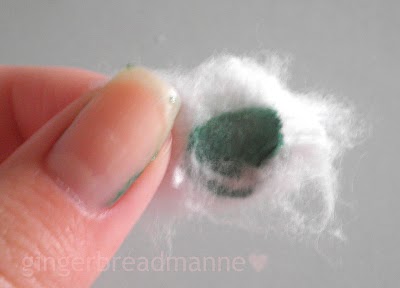
For example, I have a little varnish left around the edges because my thumb flat and not rounded like my nails, so I can't apply enough force to get the polish completely off the edges of my nails. Now repeat this procedure for all other nails.
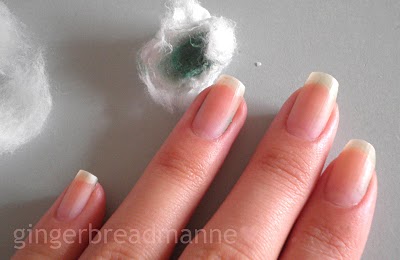
Yes, for a short time, we completely removed the nail polish. On my index finger, there is no longer any varnish on the middle finger and little finger. If we traditionally removed the polish with a cotton swab, it would take us a lot of time. Use the remaining cotton wool to remove all the polish (if any remains).
Gel polish continues to be one of the most popular decorative means manicure thanks to the increased resistance of the coating to mechanical damage and flawless appearance throughout the entire wearing period. And the nail design, made in shades from a rich palette of shellac that matches your wardrobe, will last in its original form for at least several weeks without additional correction. But even the most flawless nail design gets boring over time and you want to remove the gel polish coating in the safest way. From this material you will learn how to remove shellac yourself at home so that your nails can rest and “breathe” after a long “imprisonment” under several layers of coating.
One of the main advantages of shellac is that to remove the coating it is not necessary to file the nails and thereby expose the natural plates to mechanical damage, causing their fragility, thinning and delamination. You can buy a special shellac remover kit, which contains a special liquid that quickly softens the hard coating on your nails. But if you don’t have such a liquid on hand, then you can use other products for this procedure that you probably have on your manicure table at home. You can remove shellac from your nails even with nail polish remover, and you can do without pieces of foil to fix a cotton pad with solvent.
♦ HOW TO CORRECTLY REMOVE SHELLAC WITH A SPECIAL LIQUID
It is advisable to remove hardened gel polish from nails with a professional product to prevent delamination and thinning of the nail plates. The following brands have proven themselves well: Masura Liquid, CND Nourishing Remover, Nano Professional Remover, Solomeya Nail Remover Artificial, Nila Uni-Cleaner, Severina.
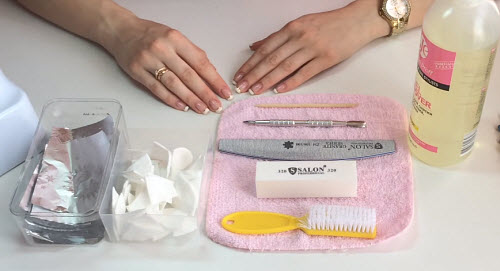
· Shellac remover;
· Buff for polishing nails;
· Thin foil (cut into square pieces);
· Cotton pads (each pad is cut into four parts);
❶ Treat your fingers with an antiseptic and place a piece of cotton pad soaked in special liquid;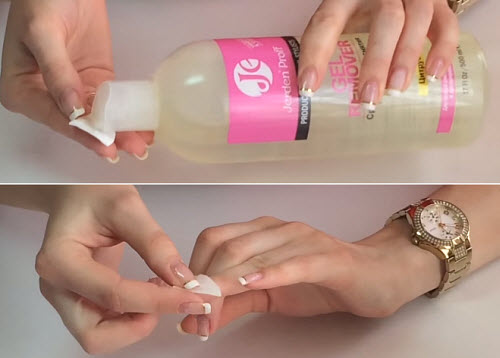
❷ To press the cotton pad tightly to the nail, twist a piece of foil around each nail plate and secure the workpiece with an “envelope”; 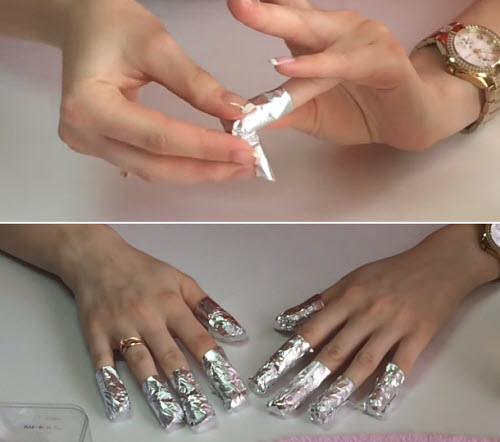
❸ After 10-15 minutes, remove all the foil “envelopes” from the fingers and carefully clean the softened coating from the nail plates with a pusher or an orange stick; 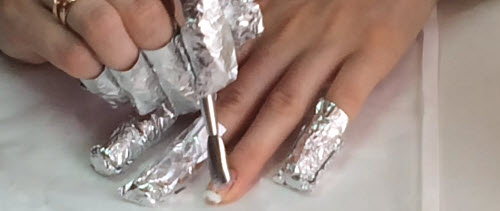
❹ A thin film of shellac may remain on the surface of the nail plates, which we remove by lightly sanding with a nail file (literally run over each nail several times), and then treat the nails with a polishing buff; 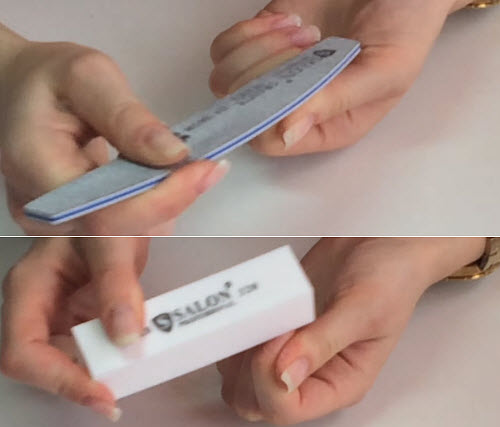
❺ After polishing the nail plates, apply a special softening oil to the cuticle with a brush, and then rub it into the keratinized skin; 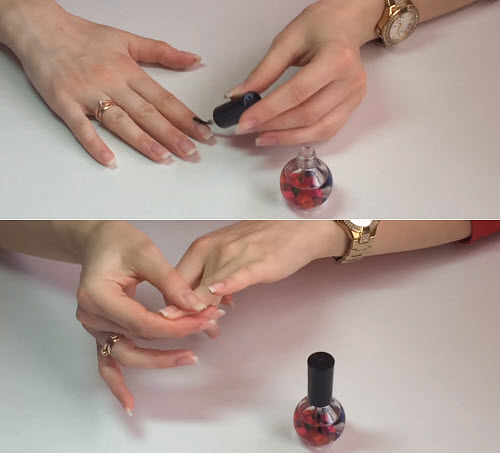
❻ If your nails look weak and thin, take a strengthening bath with sea salt a few hours after the procedure, apply a mask with red pepper to the nail plates.
♦ HOW TO REMOVE SHELLLAC WITHOUT USING FOIL
It is quite possible to perform this procedure at home without foil and cotton pads, replacing these materials with a regular adhesive plaster.
Tools and materials for the procedure:
· Gel polish remover (or nail polish remover with acetone);
· Orange sticks or a metal pusher with a rounded spatula;
· Glass or ceramic file with fine abrasive;
· Buff for polishing nails;
· Adhesive plaster, cut into 10 large pieces;
· Wide bowl;
· Vaseline or fatty cream.
· Softening cuticle oil.
Step-by-step instruction:
❶ Use a file with a fine abrasive to lightly sand the surface of the coating, removing the top layer of topcoat; 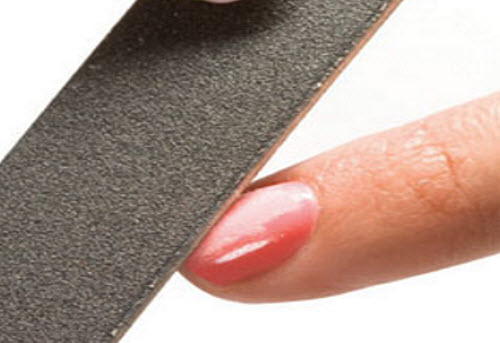
❷ Pour softening liquid into a bowl so that you can dip your fingertips into it; 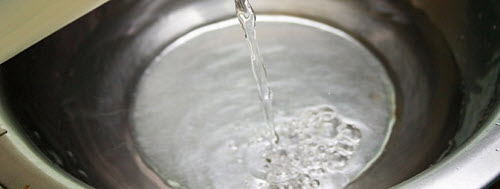
❸ Apply a thick layer of Vaseline or fatty cream to the periungual skin; 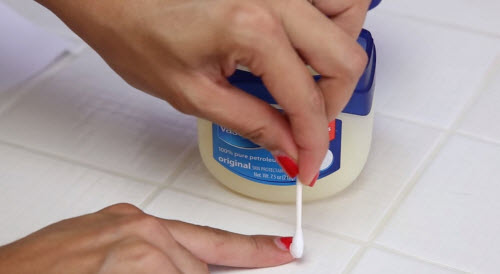
❹ We wrap the upper phalanx of each finger with an adhesive plaster and immerse the fingertips in a bowl of liquid; 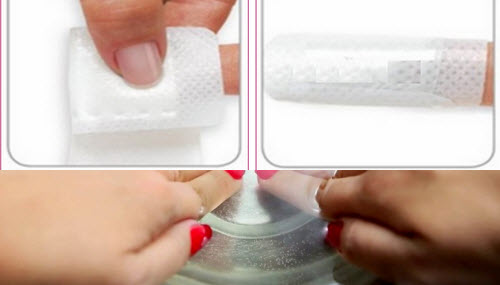
❺ After 15 minutes, remove the adhesive plaster from your fingers and carefully remove the softened coating with an orange stick or pusher, moving from the cuticle to the tip of the free edge; 
❻ Polish the surface of the nail plates with a buff and rub softening oil into the cuticle; 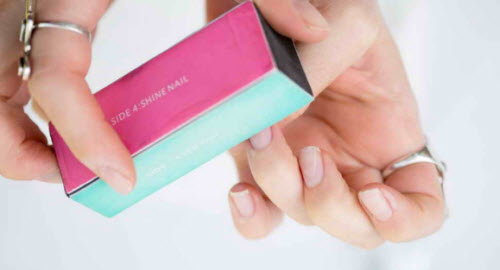
❼ After a few hours, take a bath with warm water, in which you can dissolve 4 drops of iodine and 2 teaspoons sea salt to strengthen nails.
♦ HOW TO REMOVE SHELLAC WITHOUT SPECIAL LIQUID
For the procedure, you can use acetone, which is one of the strongest solvents. But it is strictly contraindicated to use this product for owners of very thin, brittle and peeling nails. It is advisable to remove shellac without a special liquid only in emergency cases, when you urgently need to get rid of decorative manicure, and you only have acetone on hand.
Tools and materials for the procedure:
· Acetone solution (concentration no more than 60%);
· Orange sticks;
· File with fine abrasive;
· Vaseline or fatty cream;
· Cuticle oil;
· Moisturizing cream;
· Wide bowl.
Step-by-step instruction:
❶ It is advisable to warm up the acetone solution (60%) a little. Filling the pan hot water(about 1/4 volume) and place a bowl of acetone solution there (so that you can dip your fingertips into it). It is enough to keep the bowl in the pan for 3-4 minutes;
❷ Remove the top layer of shellac using a nail file, and then remove dust with a manicure brush;
❸ To protect the periungual skin from exposure to strong solvents, apply a thick layer of rich cream to the upper phalanx of each finger, without going into the nail plates;
❹ Dip your fingertips into a bowl of solvent so that the liquid completely covers the nails;
❺ Keep your fingertips in the bowl for about 10 minutes. After this time, the coating will noticeably swell and begin to peel off slightly;
❻ Then remove your fingers from the bowl and use an orange stick to remove the softened coating from each nail;
❼ After the procedure, wash your hands thoroughly with soap, wipe dry with a towel and apply moisturizer to the skin of your hands. After a few hours, it is advisable to take a strengthening nail bath.
♦ HOW TO REMOVE SHELLAC WITH NAIL VARNISH REMOVER
For this procedure, a regular nail polish remover containing acetone is suitable. We will also need foil squares, cotton pads and orange sticks;
❶ Fold a cotton pad in half and soak it in liquid, and then apply it to the shellac-coated nail;
❷ Pressing the cotton pad tightly, wrap a piece of foil around the tip of your finger, which will securely fix the cotton pad and prevent the evaporation of the solvent;
❸ After 15 minutes, remove the foil from each finger and use an orange stick to remove the shellac from the nails;
❹ Massage the skin around your nails and apply special cuticle oil to it.
♦ HOW TO REMOVE SHELLAC USING SPECIAL WIPES
Very convenient disposable napkins with impregnation in the form of covers. The napkin is opened in the area of the incision, the film is torn off and the cover is put on the tip of the finger. The napkin is hermetically attached to the finger and within 10 minutes the gel polish coating is completely softened. ![]()
- Click on the photo and expand the annotation
♦ VIDEO LESSONS FOR BEGINNERS
Moreover, it is often necessary to remove not only from the nails or the skin around the nail plate. Varnish ends up on a variety of surfaces. We need secrets on how to remove varnish. And they are in front of you.
Removing Stubborn Nail Polish from Nails
The use of high-quality and durable varnish carries with it the problem of its removal. It is especially difficult to give in. It is also difficult to remove varnish that has many layers, glitter or a complex texture. But we have a secret for this too!
Let's conduct an experiment. This nail was painted with eight (!) layers of OPI polish, Living Daylights shade (I really wanted to make the glitter opaque, just like it was in the bottle). This amount of varnish is difficult to remove; the complex texture with glitter adds to the problem, which is very difficult to remove.
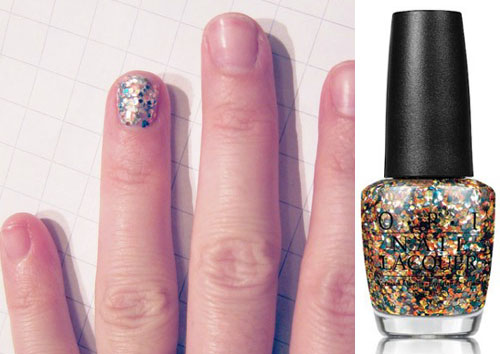
Take a cotton ball. Wet it in nail polish remover. Some people advise simply pressing it onto the nail for a few seconds. But we didn't succeed. You need to hold it longer. So take a hair tie and fix the cotton ball on your nail.
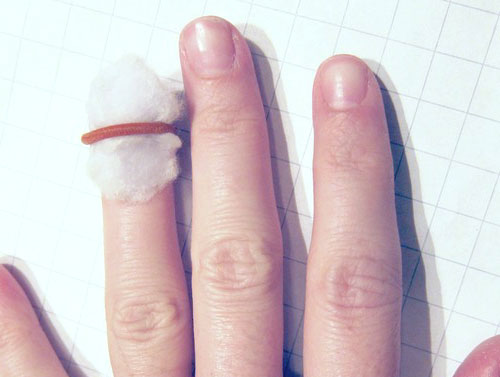
The cotton ball must be well soaked in water, because the liquid evaporates quickly in air, and the soaking effect may not work. Leave the wrapped nail for a few minutes.
Three minutes was enough for us. After removing the cotton wool, wipe your nail with it. And then again with a fresh cotton ball and nail polish remover. Everything went perfect!
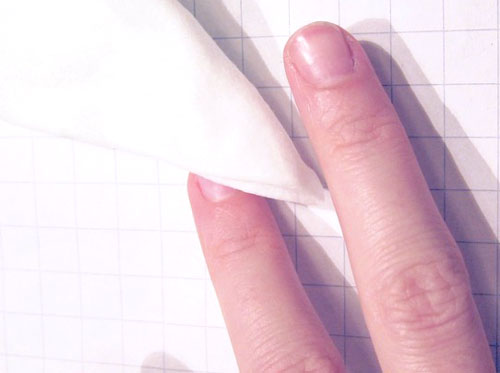
Don’t forget to moisturize your cuticles (with oil or hand cream) after the procedure.
Removing gel nails
Some salons remove old ones for extra money. Is it worth spending your savings on this? We watched how the master removed the gel in the salon and repeated the same thing at home.
For work you will need: cotton balls, foil, acetone.

Soak each cotton ball well in acetone. Wrap the nail with cotton wool and foil on top. Leave for 20 minutes.
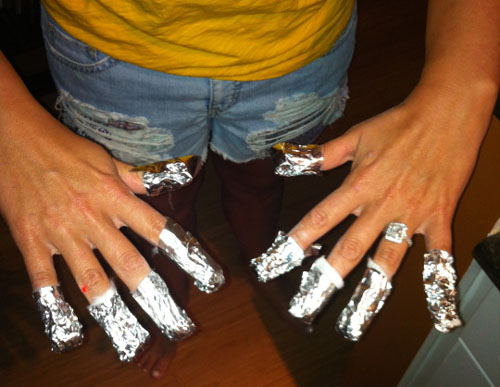
After that gel nails will begin to peel off. Take a flat stick (like the handle of a brush) and help the gel move away from your nails. After cleansing your nails, moisturize them well.
Removing nail polish from wood
First rule: do not use nail polish remover if you need to remove it from a wooden surface. Otherwise, the varnish will only be rubbed into the wood, and the wood will turn the color of the varnish forever. You will need hairspray. Prepare for what you need a large number of hairspray, much more than you would normally use on your hair. Spray the stain big amount hairspray. Leave for 20 seconds. Then wipe the stain off with a cloth. If it does not come off completely, repeat the process.
Removing nail polish from fabric
Sometimes you can use nail polish remover. Just be sure to wash the cloth after this to remove any remaining chemicals. But there are delicate fabrics, fabrics with prints, which, after interacting with nail polish remover, lose their color, crumble, and deteriorate. What to do? The first secret is the same hairspray. The second secret is dry cleaning with solvent. The third secret is stain remover and washing powder if the stain is fresh. After any cleaning, the fabric must be thoroughly rinsed.
Removing nail polish from hair
Sometimes, in a hurry, you can accidentally paint your hair with nail polish. If the stain has not dried, it can be removed quite easily. Soak a cotton swab in nail polish remover and remove the hairspray by pulling a strand through the swab. If you notice the stain too late and it is already dry, then soak a cotton swab with hair conditioner or. And pass the stained strand through the swab.
Removing nail polish from carpet
If the carpet is white or light-colored, undyed, then acetone-free nail polish remover will do. If the carpet is made of dyed threads, then nail polish remover may leave a stain and strip the dye. So use the hairspray or alcohol trick. Fill the stain, and then carefully remove the stain with a sponge or paper towel. You won't be able to clean the carpet the first time, and you may even think that the stain is getting brighter. But don't despair! Repeat cleaning several times and everything will disappear.
A girl's manicure should always be in perfect condition. Peeling nail polish looks quite ugly and not aesthetically pleasing, so if a woman does not have time to regularly change the nail polish or Money To update your manicure in a salon with gel polish, the more correct decision would be not to apply a coating on your nails at all, but only monitor the shape of your nails and cuticles. However, there are cases when the nail polish has chipped off in some places, which was noticed, for example, in the evening, in the morning next day I need to go to work, but I’ve run out of nail polish remover at home. Then the methods described below will come to the rescue, which will help you wipe off nail polish without liquid.
What is nail polish made of?
To look for the answer to the question of what can replace nail polish remover, you need to know its composition. Based on this information, you can select substances that will dissolve the components of the varnish.
So, the variety of varnishes in stores and their price range suggests that their composition is different. This conclusion can also be made based on the fact that different coatings different time are held on plates. Most varnishes include the following components:
- Polymers are the basis of absolutely any nail coating. It is thanks to him that it acquires shine and becomes hard. Polymers, for example, can be dissolved in both alcohol and acetone, however, this depends on which polymer was used in the manufacture of the product.
- Plasticizers affect the elasticity and strength of the coating.
- Pigments determine the shade of the varnish.
- Solvents directly affect the ability of the varnish to spread on the plate. Eg, ethanol is also a solvent. They dissolve within the first minutes after application.
DIY nail polish remover
The most commonly used remedy in in this case is alcohol. Liquids with its high percentage will help dissolve the coating. Their action is determined by the interaction of alcohol particles with various types of polymers. Pure medical alcohol, perfume, and hairspray can be effective in removing hairspray, but, unfortunately, not in all cases. The action depends directly on its composition. Alcoholic drinks- not the best the best remedy when choosing a solvent. If there is no other choice, then strong alcoholic drinks, for example, vodka, cognac or whiskey, can also be useful in case of a problem. To remove nail polish, it will take about 15 minutes; during this time, you should keep your nails in an alcohol solution.
Varnish can be removed with another varnish
The method of erasing an old coating with a new one has been known for a long time. That is, you can erase your nails without liquid by applying a layer of new varnish as follows:
- You need to take a bottle of regular varnish, it can be a different color from what is on the nails, as well as a paper towel, napkin or, preferably, a cotton pad.
- Apply a layer of “fresh” nail polish evenly, covering all areas of the plate.
- Without waiting for the slightest hardening of the varnish, take a cotton pad and wipe off the varnish with strong pressure.
- Thus, it turns out that the old coating will be removed along with the new one. This will happen due to the fact that nail polish contains special solvents.
It should be noted that it is better to do the above described manipulations with a prosaic coating, since streaks will not appear different color. In a similar way, you can remove nail polish using a fixative.
Other methods
This is not the end of the ways you can wipe off your nails if there is no acetone. Below are the TOP 5 methods to combat this problem:
- Perfume, hairspray or deodorant containing alcohol can be an excellent substitute. special means. Every girl is sure to have one of these products. The specifics of action when using them are the same: you need to spray the product on the surface of the nail and quickly wipe off the coating using a cotton pad or dry cloth.
- Vinegar. It is found in almost every home. You should mix 9% vinegar and water in equal quantities, dip your fingertips in the resulting liquid for 10 minutes, and then wash your hands with regular warm water. The coating will soften and be easy to remove from the nails. After the procedure, your hands may have a rather unpleasant odor, which will be almost impossible to get rid of.
- Hydrogen peroxide will also help if you have a question about how to remove nail polish without acetone. It is enough to saturate a cotton pad with it and begin to painstakingly wipe the varnish from the plates. The procedure should be carried out with caution, as peroxide leaves white spots on the skin.
- Technical acetone and paint thinner will help solve the problem. However, it is better to resort to such methods as a last resort, since the plate can deteriorate greatly, and the nails will be extremely brittle and weak for the next three months.
- In addition to acetone, it can help in this “difficult” task. toothpaste. After holding it on the plates for five minutes, you can try to remove the layer with an old toothbrush. This method is not always effective; the components of toothpaste can only remove certain types of coatings.
Thus, if you don’t have nail polish remover at home, then you shouldn’t despair, because various kinds of products that every girl has at home can come to the rescue. But these experiments may result in nail treatment for a long time, so you should think carefully before carrying out these procedures. Perhaps appearing in public with a chipped manicure is not so scary and no one will notice it at all.
Manicure at home is a common thing, and decorating nails does not require any special skills at all; even a schoolgirl can do it without difficulty. The main thing here is to be careful: just one awkward movement, and the brush with varnish stains the trousers, leaving a bright shiny mark on the fabric. The task becomes more complicated: now you need to put in order not only yourself, but also your clothes.
Detergents are powerless: neither washing powder nor laundry soap will help deal with nail polish. Do not try to wash the stain, and especially do not rub it under any circumstances, otherwise the paint will penetrate deep into the fibers of the fabric.
Fresh stain: what to do?
If you have just applied the stain, act quickly before the polish dries. Blot any drops that fall on your clothes with a napkin. Using a cotton swab, match or toothpick, carefully remove the fresh varnish - only what has already been absorbed into the fibers will remain on the fabric.
Place the item on a hard surface (table, ironing board). Place a thick paper napkin, a clean rag or a piece of gauze on the inside of the stained area. Prepare a swab with which you will treat the stain: cotton swab for small stains, a cotton pad or a small piece of cloth.
Now you can start removing the remaining stains from your clothes. To do this, you will need one of the following products: nail polish remover, acetone, gasoline or kerosene.
Before using the product, test it on the product in an inconspicuous place - for example, on the inside, on the lapel - to make sure that the solution will not damage the fabric. Be careful with colored items: some fabrics will fade when chemical solutions are applied.
Acetone
Suitable for materials made from natural fibers (cotton, viscose, wool) and some types of synthetics. Strict exceptions: silk acetate, artificial leather, nylon and its derivatives.
Drop acetone into in the right place, wait for complete absorption and wipe off traces of varnish with a swab also soaked in acetone - this product effectively removes varnish. If paint stains remain on the clothing, repeat the procedure until the fabric is clean, then wash the product with regular powder.
Nail polish remover without acetone
This is the option of choice for cleaning artificial fabric items. The liquid should be colorless: if it contains pigment, it can stain the textiles, and a new stain will have to be removed. It is used in the same way as acetone, with the only difference that after cleaning, the product should be treated with dishwashing detergent or soda to remove oil traces from the fabric.
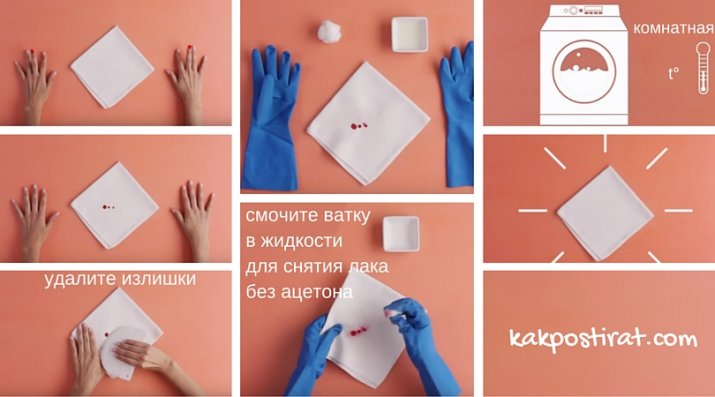 Step-by-step instructions left - down - right
Step-by-step instructions left - down - right Gasoline, kerosene
An alternative to acetone, which will help if the first remedy did not cope well with the task. Drop the liquid onto the damaged area of the fabric and leave for 10-15 minutes, then remove the stain using a swab dipped in gasoline or kerosene.
After treatment, soak white items with bleach and colored items with stain remover for 30-60 minutes to remove stains, and wash thoroughly with regular laundry detergent.
White spirit or universal solvent
If the house has this effective remedy, use it: place a cotton pad, generously soaked in the solution, on the stain, wait until it gets wet and rub the stained area with a swab. After treatment, the product must be washed with preliminary soaking.
Folk method for delicate fabrics
If the synthetic material does not require the use of the methods described above, use a delicate option: mix ammonia, turpentine and refined alcohol in equal proportions. vegetable oil and apply the resulting mixture to the area with varnish. Wait 10-15 minutes, remove any remaining paint and wash the item. You can also try cleaning “capricious” textiles with hydrogen peroxide or alcohol.
How to Remove Nail Polish from Denim
Denim fabric requires a special approach: although the natural composition allows the use of any liquid, chemical treatment of the stain may cause the fabric to lighten. Before subjecting your favorite jeans to this procedure, check them for reaction at the hem, from the inside out. Drop a little product (acetone, nail polish remover, gasoline) and if the color does not change, feel free to start cleaning, but be careful and avoid excessive friction - if you “overdo it” with this, even the most persistent shade can fade.
Stain on furniture: how to save upholstery
Sometimes you have to save upholstered furniture from the consequences of your own carelessness. A knocked over bottle of nail polish can ruin the upholstery of your favorite chair if action is not taken in time.
Remove excess enamel. To do this, use a napkin, removing and blotting the varnish in short strokes - try to remove it as quickly as possible before it dries, but under no circumstances rub it into the surface of the sofa or chair.
Wet the stained area with a chemical solution that does not damage the upholstery fabric. In most cases, this is acetone or nail polish remover. Gasoline is not recommended for cleaning furniture: a strong, toxic odor will remain in the room for a long time.
Rinse the upholstery area with warm water, preferably with the addition of furniture and carpet cleaner - it helps eliminate odors. Ventilate the room thoroughly.
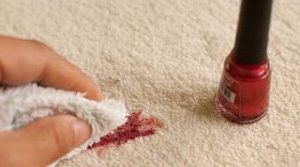 Mission Possible: Save the Carpet
Mission Possible: Save the Carpet First test the product on an inconspicuous area of the upholstery to make sure that the fabric fibers do not deform during cleaning or change color.
Apply the solution carefully, within the limits of contamination, so that the liquid does not spread to the surrounding tissue. Roll a clean cloth into a swab and rub it over the stain until it disappears.
Dried varnish: how to remove stains from fabric
Hardened varnish can also be removed from clothes, but this will take more time - first you should remove excess varnish that has already dried.
If the material is dense, you can make your task easier by using a piece of sandpaper: gently rub it over the stain to remove the top layers. If the fabric is delicate and does not allow such manipulations, you will have to arm yourself with patience and a large amount of acetone - the fabric will have to be processed for a long time, in several stages, until the stain disappears completely.
Place a sheet of paper or parchment on a hard surface and place the item on it with the stained side down, so that the stain is in contact with the paper. Iron a section of fabric from the inside out with a hot iron - the varnish layer will transfer to the paper. Replace the used sheet with a clean one and repeat the procedure again until you get rid of excess paint.
Treat the stain with a solution of acetone, gasoline or nail polish remover and remove any remaining dirt with a swab.




